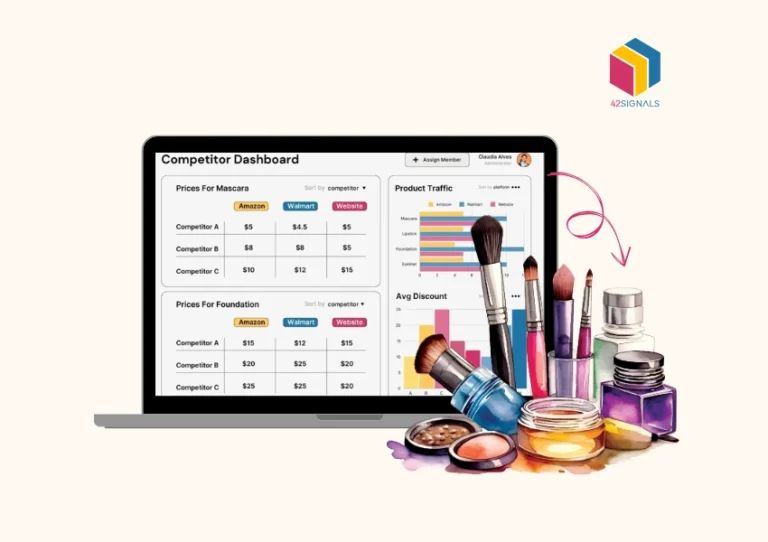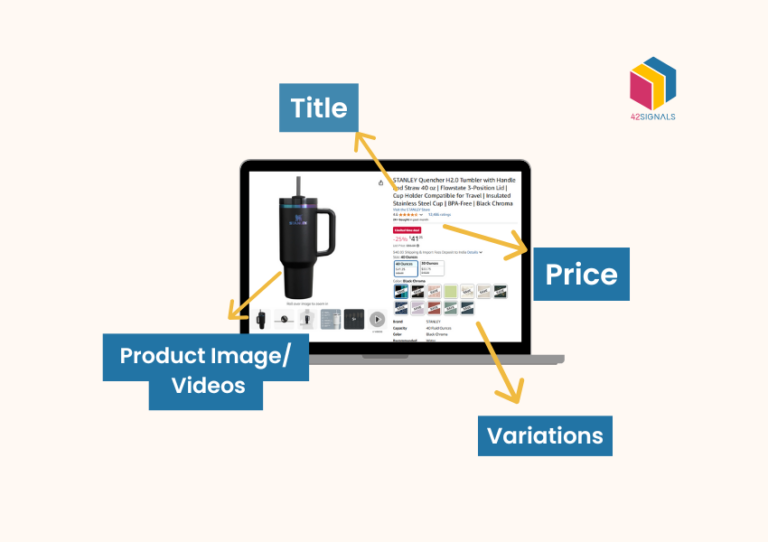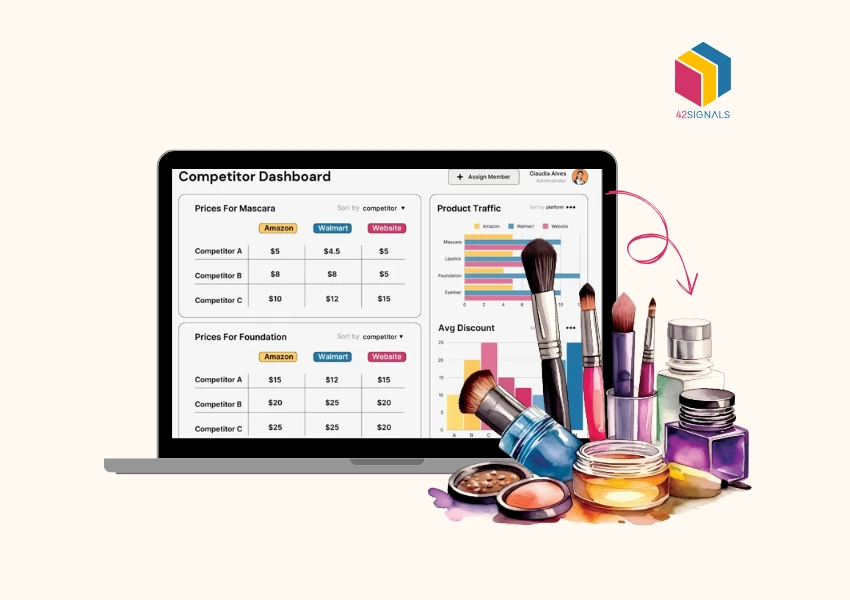A prime asset for online retailers, price intelligence empowers businesses to fine-tune their pricing strategies, monitor competitor pricing dynamics, and unravel valuable insights into consumer behavior.
In the sections that follow, we embark on a comprehensive journey, delving into the essence of price intelligence, and its pivotal role in shaping e-commerce strategy.
We will also look at the cutting-edge technologies propelling its effectiveness, and actionable steps for its seamless implementation—all geared towards fostering sustainable growth.
What is Price Intelligence?

Image Source: Capterra
Pricing intelligence refers to the process of gathering, analyzing, and interpreting pricing data in order to make informed pricing decisions. It involves monitoring competitor prices, tracking market trends, and understanding customer price sensitivity. It enables e-commerce businesses to stay competitive, make data-driven pricing decisions, and maximize profitability.
The Pillars of Price Intelligence in Online Retail
Effective price intelligence in online retail relies on two key pillars:
Competitor Monitoring
This involves actively tracking and monitoring the prices of competitors in real time. By analyzing competitor pricing data, online retailers can identify pricing gaps, spot trends, and adjust their pricing strategies accordingly.
Market Analysis
It also involves analyzing broader market trends, such as demand fluctuations, pricing strategies of key players, and changes in customer preferences. By gaining a comprehensive understanding of the market dynamics, e-commerce businesses can make informed pricing decisions.

Price Intelligence Technologies
The Tools and Tech Required
E-commerce enterprises leverage a variety of tools and technologies to seamlessly integrate price data into their operations. These tools play a major role in automating the intricate tasks of data collection, analysis, and ongoing monitoring. Within the intelligent pricing ecosystem, indispensable technologies include intelligence software, web scraping tools, and data analytics platforms.
Integrating with E-commerce Systems
Seamless integration of intelligence software with e-commerce systems is crucial for efficient price monitoring and analysis. By integrating an e-commerce pricing intelligence software into their existing platforms, businesses can streamline data collection, automate competitor price tracking, and gain actionable insights to drive pricing strategy.
Steps to Deploy a Pricing Intelligence Framework
Implementing a price intelligence framework involves several key steps:

- Define Objectives: Clearly define the specific objectives and goals of implementing it within the e-commerce business.
- Select the Right Tools: Identify and select the appropriate intelligence tools and price monitoring technologies that align with the business needs.
- Collect Data: Gather relevant pricing data from competitors and relevant market sources.
- Analyze and Interpret Data: Utilize data analytics techniques to analyze and interpret the collected pricing data.
- Implement Pricing Strategies: Incorporate insights gained from the analysis into pricing strategies, such as dynamic pricing or price optimization.
- Monitor and Refine: Continuously monitor competitor prices and market conditions, and refine pricing strategies based on real-time data.
Overcoming Common Challenges
Some common challenges include data quality issues, data privacy concerns, and the complexity of integrating price intelligence software with existing systems. However, with careful planning, robust data management practices, and reliable price monitoring partners, these challenges can be overcome to leverage their full potential.
Price Intelligence for Product Positioning
Price Positioning and Perceived Value
Intelligent pricing plays a crucial role in product positioning and determining the perceived value of a product. By analyzing competitor prices and market trends, e-commerce businesses can strategically position their products to target specific customer segments. It helps businesses understand how their prices compare to competitors and whether they align with the perceived value of their products.
Aligning Pricing Strategies with Brand Identity
It enables e-commerce businesses to align their pricing strategies with their brand identity. By understanding customer price sensitivity and market dynamics, businesses can determine whether to position themselves as a low-cost provider, a premium brand, or somewhere in between. It ensures that the pricing strategies are consistent with the brand’s image and value proposition.
Consumer Behavior Insights
Understanding Customer Price Sensitivity
Price intelligence provides valuable insights into customer price sensitivity. By analyzing customer responses to different price points and monitoring their purchasing behavior, e-commerce businesses can develop a deep understanding of how customers perceive value and make purchasing decisions. This understanding enables businesses to optimize their pricing strategies and tailor promotions and discounts to maximize customer engagement and sales.
Shaping Promotions and Discounts
Intelligent pricing helps e-commerce businesses shape their promotions and discounts by understanding competitor pricing and market trends. With real-time pricing data, businesses can identify opportunities to offer competitive deals and discounts. By strategically aligning promotions with customer preferences and market conditions, businesses can drive customer engagement, increase sales, and build customer loyalty.
Conclusion on Price Intelligence
Price intelligence emerges as a formidable asset, conferring a distinct competitive advantage upon e-commerce enterprises. Through the utilization of price monitoring technologies, businesses can dynamically adjust their pricing strategies in real-time, securing a leading position in the market and fostering sustainable growth.
A good understanding of market dynamics, customer behavior, and competitor pricing empowers e-commerce businesses to formulate judicious, data-driven decisions, optimizing profitability and delivering enhanced value to their clientele.
The imperative adoption of intelligent pricing stands as a pivotal strategy for e-commerce entities aspiring to not just survive but thrive in the dynamic and fiercely competitive landscape of the contemporary online marketplace.
Want to stay one step ahead in the e-commerce game? Look no further than 42Signals for all your price intelligence needs. 42Signals’ comprehensive suite of tools and services allows you to track competitor prices, monitor market trends, and adjust your pricing strategy accordingly.
Don’t let your competitors outsmart you – leverage the power of intelligent pricing from 42Signals and take your e-commerce business to new heights!
Frequently Asked Questions on Price Intelligence
What is pricing intelligence in retail?
Pricing intelligence in retail refers to the process of gathering, analyzing, and using data. It involves monitoring competitors’ prices, tracking market trends, and understanding customer willingness to pay. This data is used to set optimal prices that balance margin and volume objectives.
What is competitive pricing intelligence?
Competitive pricing intelligence refers to the process of gathering and analyzing data on competitors’ prices, products, and strategies. The goal is to inform one’s own pricing and business strategies.
It helps businesses by identifying opportunities to differentiate themselves through pricing, product offerings, and customer service.
What is a competitive intelligence strategy?
A competitive intelligence strategy is a plan for gathering, analyzing, and using data. This is used to gain insights into competitors’ strengths, weaknesses, and strategies.
It involves setting goals, identifying sources of information, collecting and analyzing data, and disseminating findings to stakeholders to inform business decisions.
Effective competitive intelligence strategies require ongoing monitoring and adaptation to changing market conditions and competitive dynamics.







